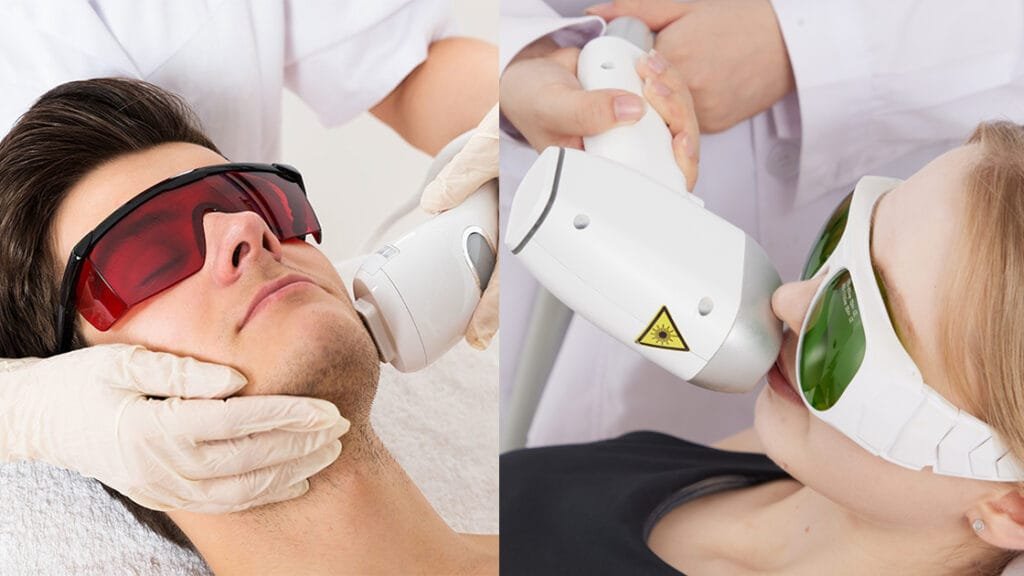Laser hair removal has revolutionized the way we approach hair reduction, offering a more effective and long-term solution compared to traditional methods. With technological advancements, modern lasers like the Artemis Diode Laser have taken the process to new heights, offering enhanced comfort, efficiency, and safety for users across different skin types and tones. This article explores laser hair removal technology, its comparison with other methods, and why the Artemis Diode Laser is the top choice for both professionals and clients.
1. Introduction to Laser Hair Removal Technologies
Laser hair removal works by using concentrated light beams to target and damage the hair follicles, disrupting their ability to produce new hair. The technology relies on specific wavelengths of light that are absorbed by the pigment (melanin) in the hair, which heats up and destroys the follicle.
1.1 How Laser Hair Removal Targets Hair Follicles
Laser hair removal operates on the principle of selective photothermolysis, where the laser light is absorbed by melanin in the hair follicle. The light energy is converted into heat, which damages the follicle without harming the surrounding skin. Multiple sessions are required to target the hair at different growth stages, ensuring long-term results.
1.2 Different Types of Laser Hair Removal Technologies
Different laser technologies are used for hair reduction, each with its unique features. The most commonly used types include:
| Laser Type | Wavelength | Best For | Key Benefits | Limitations |
| Diode Laser | 800–810 nm | Suitable for all skin types, especially darker skin tones | Deep penetration, highly effective on coarse hair | May not work on very fine hair |
| Alexandrite Laser | 755 nm | Light to medium skin tones | Fast treatment, effective on fine to medium hair | Less effective for darker skin tones |
| ND:YAG Laser | 1064 nm | Darker skin tones | Effective for deep penetration, works on coarse hair | Less effective for fine hair |
| Intense Pulsed Light (IPL) | 500–1200 nm | Light to medium skin tones | Broad-spectrum light, cost-effective | Less precise, requires more treatments |
2. Laser Hair Removal vs. Other Methods: Why Does It Win?
Laser hair removal offers several advantages over traditional hair removal methods such as waxing, shaving, electrolysis, and plucking.
| Method | Duration of Results | Pain Level | Side Effects | Suitability |
| Laser Hair Removal | Long-term (Permanent reduction) | Minimal discomfort (with cooling technology) | Mild redness, slight swelling | Suitable for all skin types and hair colors |
| Electrolysis | Permanent | Painful | Redness, scarring | Suitable for fine hair, but time-consuming |
| Waxing | Temporary (few weeks) | Moderate to high pain | Ingrown hairs, irritation | Effective for large areas, but painful |
| Shaving | Temporary (few days) | Minimal pain | Razor burns, cuts, ingrown hairs | Quick and easy, but short-lived results |
| Plucking | Temporary (few weeks) | High pain | Skin irritation, ingrown hairs | Suitable for small areas, but very painful |
3. The Artemis Laser: The Top Contender in the Market
The Artemis Diode Laser stands out as one of the most advanced and reliable lasers on the market today. Combining state-of-the-art technology with a user-friendly design, it provides unmatched performance in terms of precision, speed, and patient comfort.
What Makes the Artemis Laser Stand Out?
Advanced Cooling Technology
The Artemis laser is equipped with advanced cooling technology, which ensures the skin remains cool throughout the treatment. This reduces discomfort and allows for a virtually painless experience. Studies have shown that lasers with cooling technology reduce pain by up to 30% compared to those without it.
Precision and Speed for Faster Treatments
The Artemis laser features high-powered pulses that enable faster treatments compared to other machines. This makes it an ideal choice for clinics that need to perform multiple treatments per day while maintaining high precision and effectiveness.
Safe for All Skin Types and Tones
Unlike older laser systems, the Artemis Diode Laser is versatile and safe for all skin tones, from light to dark, thanks to its adjustable settings and wavelength of 808 nm. This makes it an excellent choice for a diverse range of clients.
Ease of Use for Technicians
The Artemis laser’s user-friendly interface and ergonomic design make it easy for technicians to operate, even during long hours. With a streamlined setup and intuitive control system, the Artemis ensures efficient and accurate treatments.
Long-Term Reliability and Durability
Known for its reliability, the Artemis Diode Laser is built to last. It has an extended lifespan of over 15 years, making it a long-term investment for clinics. This durability helps maintain low operational costs over time, offering greater return on investment.
Patient Comfort and Satisfaction
Patients who use the Artemis Diode Laser report higher satisfaction rates due to the comfortable treatment experience. The cooling technology, fast speed, and precision ensure minimal discomfort and superior results, making it a top choice for clinics around the world.
| Laser Machine | Performance | Cost Efficiency | Patient Comfort | Long-Term Durability |
| Artemis Diode Laser | High precision, fast treatment | Cost-effective with fewer sessions | High comfort due to cooling technology | Excellent (15+ years lifespan) |
| Competitor A | Moderate speed, less precise | Higher cost per session | Moderate (no cooling) | Moderate (10 years lifespan) |
| Competitor B | Slower, less effective on coarse hair | Expensive over time | Moderate (longer sessions required) | Low (5–7 years lifespan) |
4. Laser Hair Removal: Before and After
Understanding the laser hair removal process before and after treatment is essential for optimal results. Below is a detailed breakdown of what to expect, how to prepare, and how to care for your skin post-treatment.

4.1 What to Expect Before Your First Laser Hair Removal Session
Proper preparation is key to ensuring a safe and effective treatment. Here are the essential steps:
- Avoid sun exposure for 2–4 weeks before treatment. Tanned skin increases the risk of burns and pigmentation issues.
- Shave the treatment area 24 hours before your session. This allows the laser to target the follicle without burning surface hair.
- Do not wax, pluck, or use depilatory creams for at least 4 weeks prior. These methods remove the hair root, making laser treatment ineffective.
- Avoid skincare products with retinol, AHAs, or chemical peels a few days before treatment. These products can increase skin sensitivity.
- If required, perform a patch test. This ensures your skin reacts well to laser energy, reducing the risk of irritation.
- Do not apply lotions, deodorants, or perfumes on the treatment day. Clean, dry skin improves the laser’s effectiveness.
4.2 The Post-Treatment Process
After laser hair removal, following proper aftercare minimizes side effects and enhances results. Here’s what to expect:
- Mild redness and swelling around hair follicles, similar to a mild sunburn, is normal and should subside within a few hours.
- A slight warm or tingling sensation may occur but typically fades quickly.
- Hair shedding begins within 7–14 days. It may appear as if the hair is “growing” before falling out.
- Results improve gradually with each session. Hair becomes finer and grows back more slowly.
Post-Treatment Care Tips
- Apply aloe vera gel or a cooling cream to soothe the skin and reduce redness.
- Avoid sun exposure and use SPF 50+ sunscreen to prevent pigmentation changes and skin irritation.
- Do not wax, pluck, or epilate between sessions. Shaving is the only recommended method of hair removal.
- Avoid hot showers, saunas, and intense exercise for 24–48 hours. Heat and sweat can cause irritation.
- Keep the treated area moisturized daily to promote healing and enhance hair shedding.
4.3 Maintenance Sessions and Long-Term Results
Laser hair removal provides long-lasting hair reduction, but maintenance sessions are needed for the best results.
- Most areas require 6–10 sessions, spaced 4–6 weeks apart.
- A few maintenance sessions per year may be needed to keep hair regrowth minimal.
- Thicker hair (like on the back or chest) may require more sessions.
- Once optimal results are achieved, touch-ups every 1–2 years help maintain smooth skin.
5. Addressing Gender-Specific Needs in Hair Removal Treatments
Laser hair removal has gained significant popularity among both men and women. With its efficiency and long-lasting results, it offers an ideal solution for various grooming needs.
5.1 Women and Laser Hair Removal
Women commonly seek laser hair removal for a wide range of areas. The precision and comfort of modern lasers like the Artemis Diode Laser allow for a seamless experience in the following areas:
Face: Women often use laser hair removal to target facial hair, including the upper lip, chin, and sideburns. The Artemis Diode Laser’s cooling technology ensures a pain-free and safe treatment, even for delicate facial skin.
Arms and Underarms: Unwanted arm and underarm hair is another common concern. The Artemis Diode Laser can reduce hair growth effectively, offering smoother and longer-lasting results compared to shaving or waxing.
Bikini Line and Brazilian Area: Laser hair removal is a go-to solution for women seeking a neat and smooth bikini line. The precision of the Artemis Diode Laser ensures thorough hair removal in this sensitive area without discomfort, especially due to its advanced cooling system.
Legs and Back: For those tired of regular shaving or waxing, laser hair removal provides a long-term solution for the legs and back. Women with busy schedules find this a time-saving and cost-effective option.

5.2 Men and Laser Hair Removal: Increasing Popularity
Laser hair removal for men is on the rise, as many opt for smoother, more defined looks. The Artemis Diode Laser is perfectly suited for men due to its versatility, precision, and ability to handle coarse hair types effectively.
Chest and Abdomen: Men often choose laser hair removal to remove chest and abdominal hair. This method provides a clean, smooth look, especially for those who prefer the “shaved” look without the hassle of constant shaving or waxing.
Back and Shoulders: One of the most popular areas for men, the back and shoulders are prone to thick, coarse hair. The Artemis Diode Laser targets these areas efficiently, reducing hair growth and providing long-lasting smoothness.
Facial Hair (Beard and Neck): Many men are now opting for laser hair removal for facial hair grooming, particularly for the beard and neck areas. The precision of the Artemis Diode Laser ensures a well-defined beard line, making it a popular choice for those looking for clean edges or reducing ingrown hairs.
Arms and Legs: Similar to women, some men prefer laser hair removal for their arms and legs to reduce the time spent on daily shaving. The Artemis Diode Laser is effective even on thicker and coarser hair types, providing smoother, longer-lasting results.
6. Frequently Asked Questions (FAQs)
6.1 Is Laser Treatment Safe for All Skin Types?
Yes, the Artemis Diode Laser is designed to be safe for all skin types, including darker tones, due to its adjustable settings.
6.2 Does Laser Hair Removal Hurt?
The Artemis laser uses advanced cooling technology that reduces discomfort significantly, making it a comfortable option for most clients.
6.3 How Many Sessions Are Needed for Permanent Results?
Typically, 4–6 sessions are required to achieve permanent results, depending on the area being treated.
6.4 Can Laser Hair Removal Be Used for Sensitive Areas (Bikini, Face)?
Yes, Artemis is designed to be effective and safe for sensitive areas such as the bikini line and face.
6.5 What Should You Do Before and After Laser Hair Removal to Maximize Results?
Avoid waxing or sun exposure for 2 weeks before your session. Afterward, apply soothing lotions and avoid sun exposure to enhance results.
6.6 Is Laser Hair Removal More Expensive Than Other Methods?
While the upfront cost may be higher, laser hair removal saves money in the long run by eliminating the need for frequent treatments.
7. Reference
Mechanism of Laser Hair Removal








